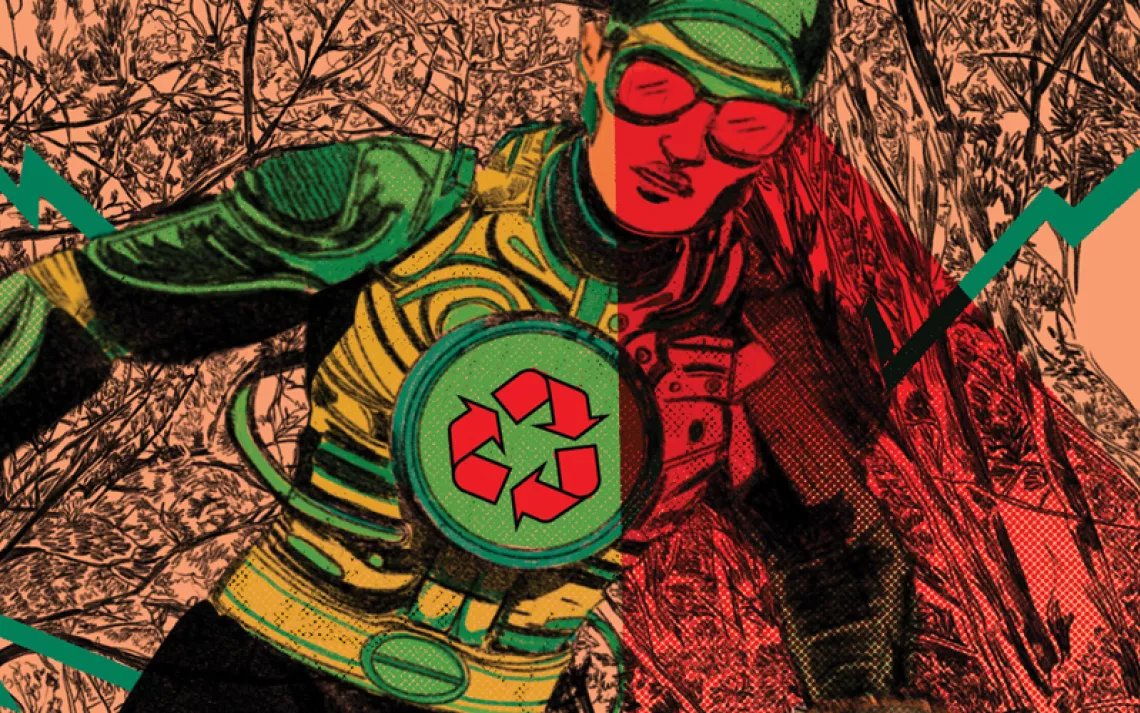Climate Fiction and Dune: Lost in Adaptation
Frank Herbert’s "Dune" is a work of climate fiction. So why have filmmakers struggled to make the eco-plot clearer?

Photo courtesy of Landmark Media/Alamy
Since antiquity, writers have dedicated their literary works to family members, friends, lovers, and muses. Frank Herbert dedicates his sci-fi epic Dune to scientists who work in deserts. The book, which Herbert calls an "effort at prediction," honors "dry-land ecologists, wherever they may be, in whatever time they work." The note also serves as a tip-off, the author's attempt to establish his environmental intent from the jump and make sure readers don't miss it.
Dune is a modern classic. A winner of the Hugo Award and the Nebula Award, the two most prestigious honors in science fiction, the epic has sold nearly 20 million copies since its 1965 publication. Today, it is considered one of the first works of what critics call climate fiction, or cli-fi. It's easy to see why. Beneath the surface-level story about space witches and giant sandworms, Dune is a love letter to the desert as well as an environmental parable. The novel examines what happens when humans try to bend nature to their will and, as Herbert wrote in his dedication, predicts the ramifications of abusing a land for its resources. In addition to being an environmental allegory, Dune is literature with a capital L: It's a subversion of the hero's journey and a warning about the dangers of religion as well as a sharp critique of imperialism. And this is just the first novel in a dense, 23-book series. No one would accuse Dune of being simple, and that's perhaps why the bestseller has often been considered "unfilmable." Which hasn't stopped movie directors from trying—with mixed results.
The two most popular attempts—David Lynch's 1984 adaptation and Denis Villeneuve's two-part blockbuster, the second half of which is being released today—employ wildly different strategies to make the labyrinthine plot digestible. But notably, both downplay the novel's environmental message and treat the book's ecological themes as extraneous rather than essential. The omissions are a shame, since they rob moviegoers (many of whom are unlikely to pick up the nearly 900-page tome) of the opportunity to grapple with serious environmental issues on the big screen. Dune the novel is rich with ideas about climate change, geoengineering, human hubris, and desert ecology. So far, filmmakers have barely touched these ideas and failed to capture the ecological heart of the story.
Mountains, forests, and otherworldly seascapes are often used in media to make the point that nature is in danger. Drylands, not so much.
If you've never achieved the Olympian feat that is reading Dune, here's the story in a nutshell: The desert planet Arrakis is the lone producer of "spice," both a hallucinogen and the substance essential for space travel, making the world a contested geopolitical treasure. Amid an interstellar power struggle, protagonist Paul Atreides and his family are sent to the arid world to oversee the mining of spice. We quickly learn that they are unwelcome colonizers on a planet already inhabited by people—the Fremen—and the sandworms, which have a symbiotic relationship to the all-important spice. Throughout the Dune series, the Fremen and the colonists wrestle with resource scarcity and the desire to terraform Arrakis into a more hospitable place. But making the world a paradise for humans means endangering the supersize worms and, along with them, the spice. In Dune, environmental and capitalist interests clash and converge in the struggle to control the planet.
As the tens of millions of copies sold prove, Dune is as gripping as it is lengthy. But in its earliest versions, Dune wasn't a novel; it wasn't even fiction. In his book The Spice Must Flow, geek-culture expert Ryan Britt explains that Dune was initially a newspaper article. Herbert, working as a freelance journalist, originally set out to cover government attempts to halt migrating sand dunes in coastal Oregon. The article never saw the light of day, but his research planted the seed for what would become one of the most enduring sci-fi novels of all time.
The novel's origin story helps illustrate Herbert's environmental intentions, as do the author's many public comments on the book. In a 1969 interview about Dune at California State University, Fullerton, Herbert asserted that he had long believed "that man inflicts himself on his environment. That is . . . Western man." But, as Britt points out, Herbert started explicitly referring to Dune as an environmental allegory only years after its publication, playing up the book's ecological themes as the burgeoning environmental movement claimed the novel as its own. Readers in the 1960s understood Dune as a thinly veiled metaphor for the global demand for oil, an interpretation strengthened by Herbert's arguably problematic use of Middle Eastern culture and language within the story.
Given that readers and book critics immediately pegged Dune as a prescient environmental text, how is it possible that film directors adapting the story for the screen have treated ecology as a minor theme? In the case of Lynch's Dune, the minimizing is likely because the director was so preoccupied with being faithful to the book that the movie became overstuffed; there simply wasn't room to dwell on environmentalism. Lynch's work is famously abstract and menacing, and in his hands, Dune became a grotesque fever dream. The movie flopped and is widely considered incomprehensible; the film's inability to pick up on the ecological ideas Herbert put down is the least of its problems.
In stark contrast to the plot-heavy Lynch version, Villeneuve's recent adaptation is sleek and spare. The 2021 first installment did well at the box office, proving that with better special effects and the ability to split up the story into multiple parts, it is in fact possible to successfully translate Herbert's convoluted novel to the screen. But while Villeneuve's version makes more of an effort than Lynch's to explore some of Dune's meatier themes, like colonization, it fails to nail the environmental ideas.
During a press conference following the release of the first part of Dune, Villeneuve connected his film to climate change, saying that the book is "a prediction of what will happen" in the 21st century and about "survival." You'll have to take his word for it. As Lynch did in 1984, Villeneuve does occasionally tap into the source material's environmentalism through visual storytelling. In one shot, villain Baron Harkonnen (played by Stellan Skarsgård) plots to overthrow House Atreides and exterminate the Fremen as he's submerged in a vat of oil—a subtle detail that could be interpreted as linking the fight over spice on Arrakis to the struggle for petroleum on Earth. In another scene, Paul Atreides (played by Timothée Chalamet) is stranded in the deep desert, where he spots what looks like a long-eared jerboa licking sweat off its ears to stay hydrated. They exchange a look, each seemingly surprised by the other's ability to survive in the arid environment.
The movie is interspersed with peaceful shots, like the one of the jerboa, and sublime, stunning images of endless sand Dunes. In this way, Villeneuve succeeds in showcasing drylands as places full of life and beauty, rather than sites of just desolation. A quick perusal of the movie's Rotten Tomatoes page, however, suggests that the adaptation's ecological undertones eluded most critics. It doesn't help that deserts are rarely the setting for so-called environmental movies. Films like Princess Mononoke and Avatar pull at viewers' heartstrings by depicting lush, green landscapes under threat. Mountains, forests, and otherworldly seascapes are often used in media to make the point that nature is in danger. Drylands, not so much.
Of course, a film doesn't need to (and probably shouldn't) bash viewers over the head to get a message across. But because audiences aren't primed to understand desert-set movies as "environmental," Dune could've done a bit more sermonizing.
Villeneuve clearly considers Herbert's novel an ecological story, but his adaptation prioritizes visual aesthetics and world-building at the cost of some of the book's core ideas. The environmental subtleties are so subtle that they get lost. In a 2021 interview, Villeneuve acknowledged that he "just skimmed the surface of some ideas that will be approached deeper in the second movie." If so, he's got plenty of material. Trailers for the second part, though, suggest more explosions, not more ecology.
The second half of Dune (the book) is weirder and more radical than the first. In the deep desert, Atreides assimilates into Fremen culture, and his desire to protect Arrakis grows. Similarly, it took time for Herbert himself to fully own his book as an environmental one—only after he realized readers were making those connections themselves. Perhaps Villeneuve's second installment will undergo a comparable process of maturation. As the character Chani (played by Zendaya) says at the end of Dune: Part One, "This is only the beginning."
 The Magazine of The Sierra Club
The Magazine of The Sierra Club



